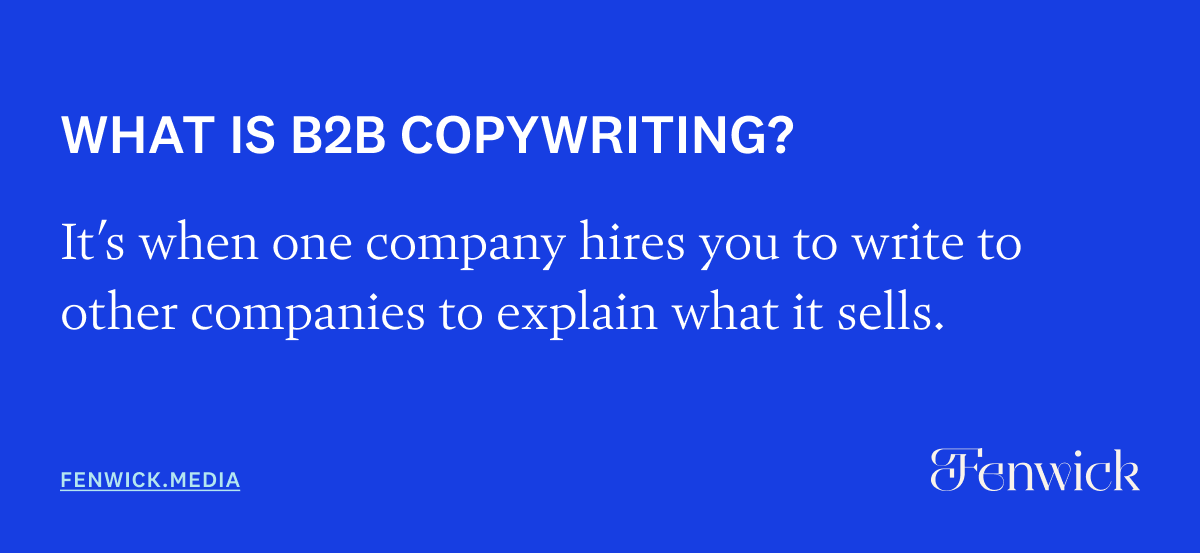Business-to-business (B2B) copywriting is when you write for a company that wants to explain to other companies what it sells. That’s how a lot of companies make money—selling to other companies. Like when IBM sells servers to General Electric.
What do B2B copywriters write? Articles, essays, websites, brochures, manuals, newsletters, and lots else. It's a splendid vocation. You’ll get paid to intellectualize and solve puzzles, and you'll become a distinctly sharp thinker, skilled at helping others logic through problems.
Who writes B2B copy?
Anyone who works for a business-to-business (B2B) company, from salespeople to product managers. Very few of them are trained as B2B writers, though, and that’s a shame, because you must be clearer and more precise than you would be in, say, a company selling to consumers.
To write for B2B, you must be a thinker. You can’t just know about your own company’s products. You have to understand what your customers sell as well, and how even what your customers’ customers sell, because that’s the key to understanding what causes one company to buy from another—and thus who you should write to, and what about.
Said another way, you must learn to think in three degrees:
- First degree: How your company makes money.
- Second degree: How your customers make money.
- Third degree: How your customers’ customers make money.
Let’s explore an example. If you’re a B2B copywriter at IBM and you want to write brochures to sell servers to IT managers at General Electric, you have to know why your servers are different, why those servers matter to those IT managers, and why those IT managers having the right servers is good for General Electric’s customers. That’s how those IT managers will be evaluating them—on how it helps their company, in turn, sell things.
"You have to understand what your customers sell as well."
All to say, B2B copywriting is complex and not a challenge of mere wordsmithery. You can’t just invent an alluring catch phrase based on your personal tastes; you have to invent a catchphrase that intrigues an IT manager (or whoever) based on how they are measured and motivated to accomplish their job. You have to be a step ahead of them, offer new and useful information, and if possible, know more about servers than they.
So that’s the intellectualizing part of the job, and it’s why B2B copywriters must be so smart. They must know a little bit about a vast array of things, and know where to look up information, find people to interview, and then write like one of those IT manager’s peers.
But most people writing B2B copy are doing so without a license.

Probably the most prolific writers of B2B copy are marketers. They’re in charge of doing all that external communicating and they need to fill websites, blogs, publications, resource pages, webinar decks, and untold other “properties” both digital and print. They hire writers. But they also benefit tremendously from being clear writers themselves. Writerly marketers don’t have to do nearly as much waiting on others.
Sales teams also benefit from learning to write copy. Most are also untrained in how to phrase and arrange words and a little bit of rigor can add up to lots of new calls with prospective customers. Same goes with customer success teams who need to create documentation end users will actually understand. Same goes for developers, designers, and UX writers creating copy for apps and other online experiences. Wherever a B2B brand needs to communicate what it does, there’s an opportunity for a B2B copywriter, or someone to become one.
And now you’re probably curious, have we got any real life examples?
B2B Copywriting examples
We here at Fenwick run a content studio and specialize in uncommonly clear writing and design—especially for business-to-business companies. Here are articles, guides, and courses we’ve written for our clients, plus what we like about each example.
Why I think Your AI Assistant Should Not Be Funny—Hot take.
The 2024 Blood Crisis—Direct, alluring, and factual.
Account-Based Marketing 101—A plainspoken, straightforward explanation of a topic that often feels complex and “hand wavey.”
Citizen Developers Are Going to Need a Leader—The French Revolution analogy really helps you grok what’s happening here.
How to Write the Best Sales Emails—The specificity. It’s bracingly practical.
GTM Course—B2B writing doesn’t always have to be an article. Why not break a long guide into what we call a “tiny course”? (Lessons delivered via email.)
Shan-Lyn Ma on founding Zola, “a company that would do anything for love”—Fun title, insightful profile.
The Best B2B Blogs to Nourish Your Writer Brain—Lots of great examples of great writing.
For more, read Rewild Magazine.
The many purposes of B2B copywriting
Every B2B writing project begins with a ‘why’—companies want to create copy or “content” to fulfill specific goals. Here are some of the most common ones:
1. Generate awareness
A lot of B2B copy is geared toward the early stages of the buyer’s journey (or the top of the sales funnel, if you prefer). This is the phase in which a potential buyer has recognized they have a problem and are starting to think about possible solutions.
Writers create copy for this stage to help brands generate awareness among potentially interested buyers. This might mean writing copy for social media advertisements or SEO web pages which answer a question that people commonly type into search engines (you may have caught on that this post is one of them). It might also mean creating blog posts and other content that helps a brand establish itself as a trusted source of advice, or an executive as a thought leader in an industry.
The idea is to educate readers about the problems they are facing and entice them to learn more about a solution, one of which may be the company’s products.
Examples:
2. Attract leads
Another kind of B2B copy that’s in high demand is content directed at potential buyers—known as “leads” in marketing speak—who are interested in a brand but are still weighing their options. The goal of this kind of writing is to inform readers about a product and persuade them it’s a good fit for their needs. These types of content are often long-form anchor pieces such as e-books and guides paired with short-form e-newsletters and emails to promote it.
Examples:
3. Close deals
B2B copywriters also support sales teams by creating content they can use in conversations with prospective customers. These resources might take the form of slide decks, white papers, or success stories from existing customers—really any kind of content that can help a prospect make a final decision to buy. While a well-written and persuasive slide deck won’t necessarily make a deal, a presentation riddled with errors can certainly break one, so this kind of writing is vitally important.
Examples:
4. Create an exceptional customer experience
The need for compelling B2B copy doesn’t end when a customer decides to buy—in fact, that’s just the beginning. Businesses need UX writers to obsess over precise word choice that makes their websites or software simple and intuitive to navigate.
Brands also use B2B writers to create documentation that allows users to understand and utilize their products effectively. For instance, brands employ technical writers to create manuals, write user guides, and FAQ sections in a way that’s searchable, digestible, and reader-friendly.
Examples:
- Website copy
- Copy inside of software, apps, and other user portals
- Manuals and how-to guides
- FAQs
What makes good B2B copywriting?
The qualities of good B2B copywriting are similar to any other kind of good writing. The best B2B blogs are concise, persuasive, and even witty. But B2B readers also look for other qualities that you might not find in, say, a news article or a page-turning novel. An Edelman-LinkedIn study investigated what C-suite executives and other decision-makers want to see in the thought leadership content produced by other companies—here are some of their top choices:
1. Industry insights
Approximately 78 percent of decision-makers and C-level executives say the most successful thought leadership they consume discusses industry-specific challenges and trends.
2. Digestible format
Approximately 69 percent of decision-makers and C-suite executives prefer short-form content and around 65 percent want to see content that provides data points, charts, infographics, or other figures.
3. Relevant and applicable advice
Sixty-three percent of both decision-makers and C-suite executives look for content relevant to projects they are currently working on.
Start writing B2B copy
The most exciting part about B2B copywriting? Right now, it’s a huge opportunity for freelancers. B2B companies are clamoring for writers who can communicate what they offer to the world in a clear, compelling way. And they’re willing to pay for it.




